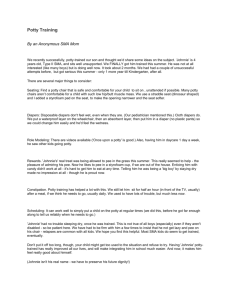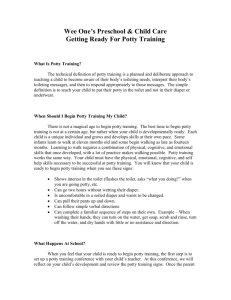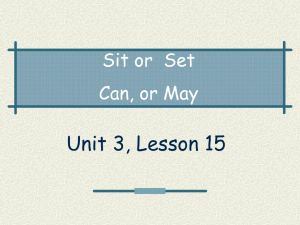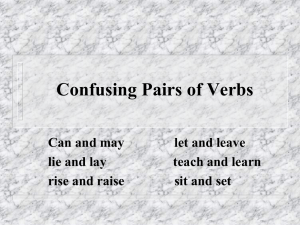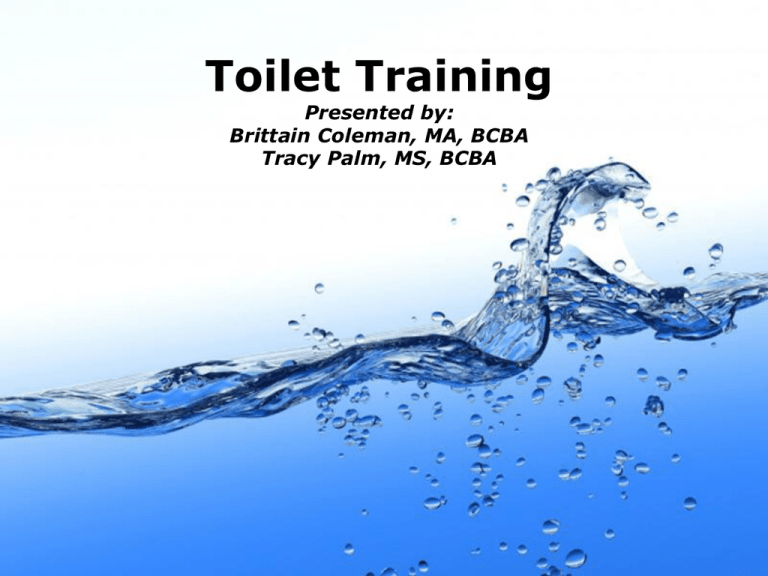
Toilet Training
Presented by:
Brittain Coleman, MA, BCBA
Tracy Palm, MS, BCBA
Page 1
Method #1
Habit training is a type of toilet training in
which the goal is to develop toileting
behavior through repeatedly doing a
behavior in the same way over and over.
Page 2
Who is Habit Training
appropriate for?
• No awareness of need to urinate/defecate
• Person is over 5 years of age & other training techniques
have been unsuccessful
• Individual is cognitively functioning age 3 or lower
• No awareness or change in behavior when diaper or
clothes are wet
Page 3
Starting a Habit Training
Program
• Know your child’s current bladder & bowel schedule.
• Keep your child on a regular diet, including drink
consumption, and exercise throughout.
• Pick times that are 5-15 minutes before your child
typically goes.
• Develop visual aids to show each step, this can be very
useful if you have a visual learner.
• Find a timer that will be used for Habit Training only.
Page 4
Habit Training Cont.
• Tell the individual that when the timer goes off that
he/she is going to take a “potty break”.
• Set the timer for the predetermined time.
• When the timer goes off then tell the child, “it’s potty
break time”.
• Prompt the individual as need to go through the steps of
toileting. You can use other ABA procedures to teach the
steps of toileting, such as behavior shaping, chaining,
differential reinforcement, etc.
Page 5
Habit Training Cont.
• The individual does not have to sit for a long
period of time. Start out with just having the
individual sit for a few seconds.
• As the person becomes more compliant and
independent with the tasks of toileting then you
can extend the time that the individual is
required to sit.
• After the individual has completed the toileting
tasks then reinforce the behavior.
Page 6
What to do if the individual has
limited or poor awareness…
• Applying physical pressure on the lower abdomen over
the bladder in order to allow complete emptying of the
bladder.
– Consult for doctor, PT or OT
• Trouble with beginning urination? Try turning on the
faucet or pouring lukewarm water over a boy’s penis
• Relax- Some people need to be distracted in order to
relax enough to go. Use toys, books, running water, etc.
Page 7
Teaching Bowel Movements
• This usually follows bladder control.
• Is there something reinforcing the behavior
of going in the diaper or in another
location?
• Use pictures that clearly show what the
child is to do and expect.
Page 8
Does it work?
This was a 3 yr old, child with ASD. He was
vocal. He was unable to tell when he “went”.
Page 9
References
• Ando, H. (1977). “Training Autistic Children to Urinate in
the Toilet Through Operant Conditioning Techniques.”
Journal of Autism and Childhood Schizophrenia, 7, 151163.
• Fouse, B., & Wheeler, M. (1997). A Treasure Chest of
Behavioral Strategies for Individuals with Autism.
Arlington, TX: Future Horizons, Inc.
• Wheeler, M. (2007). Toilet Training for Individuals with
Autism or other Developmental Issues. Arlington, TX:
Future Horizons, Inc.
Page 10
Questions?
• Contact Information:
Tracy Palm, MS, BCBA
Founder/Executive Director
Transformations Autism Treatment Center
(901) 231-1931 office
tracypalmaba@aol.com
www.transformingautism.com
Page 11
Common Trends
• All to often it seems as if toilet training is not
addressed until later in childhood and
sometimes not until teenage or even adult
years
• SO I wanted to face this issue head on…
Page 12
Method #2:
•Direct Contingency Toilet Training
•Based on the method created by Foxx and Azrin,
1971, 1973
•Method replicated multiple occasions with the same
general results
Page 13
Direct Contingency
Training
• Direct Contingency Training is
comprised of several different components:
•
Intensive schedules for:
• Time on potty
• Time off potty
• Fluid intake
•
Programmed Consequences for:
• Successful Urinations
•
•
•
Self-Initiations
Positive Practice for accidents
Communication Training
Page 14
Intensive Schedules
Hour:
Sit on Potty
How much time
Drink Schedule
between sits
1
5 min sit
5 min off
every 5 minutes
2
4 min sit
10 min off
every 10 minutes
3
3 min sit
15 min off
every 15 minutes
4
2 min sit
25 min off
every 30 minutes
5
1 min sit
35 min off
every 30 minutes
6
1 min sit
45 min off
every 30 minutes
7
1 min sit
60 min off
every 30 minutes
8
1.5 hours off
every 30 minutes
9
1 min sit
1 min sit
2 hours off
every 30 minutes
10
1 min sit
2.5 hours off
every 30 minutes
11
1 min sit
3 hours off
every 30 minutes
12
1 min sit
4 hours off
every 30 minutes
Page 15
Programmed
Consequences
• Frequent mini preference assessments are
conducted
• A few of the more highly preferred reinforcers are
used only for toilet training
• Delivery of reinforcers are contingent upon the
following two behaviors:
• Successful Urinations
• Self-Initiations
Page 16
Positive Practice
Positive Practice for accidents
• Tell the client “No wet pants” in a firm voice in the
spot where the client had an accident.
• Take the client to the potty and have the client sit
on the potty for 30 seconds. While the client is on the
potty provide little to no attention.
• After the 30 seconds on the potty return to the
location where the client had the accident and repeat
steps 1 & 2 five times unless during one of the times
on the potty the client has a successful urination.
• IF THE CLIENT HAS A SUCCESS: praise the
client, sing songs, and deliver a reinforcer. Positive
practice discontinues until the next accident.
Page 17
Participants
6 participants
• All under 3 years old
• 5 boys, 1 girl
• 2 completely non-verbal
• 4 with limited language skills
Page 18
Results
• 4 of the clients are now considered “potty trained” by
our standards
• 2 of the clients discontinued potty training for the
following reasons:
• 1 of the clients temporarily discontinued all
services due to illness
• The other client discontinued potty training as
per the parents requests because of personal
reasons
• HOWEVER, the data for the two clients who
discontinued potty training was consistent with
the 4 other clients who were successful
Page 19
Results: Client # 1
8
7
6
5
Accidents
4
Success
Self-Initiations
3
2
1
0
1
2
3
4
5
6
7
8
9
10
11
12
Page 20
Results: Client # 2
7
6
5
4
Accidents
Success
3
Self-Initiations
2
1
0
1
2
3
4
5
6
7
8
9
10
11
Page 21
Results: Client # 2 con’t
50
45
40
35
30
Accidents
25
Success
Self-Initiations
20
15
10
5
0
12
Page 22
Results: Client # 3
8
7
6
5
Accidents
4
Success
Self-Initiations
3
2
1
0
1
2
3
4
5
6
7
8
9
10
11
Page 23
Results: Client # 3 con’t
60
50
40
Accidents
30
Success
Self-Initiations
20
10
0
12
Page 24
References
• Azrin, N. H., & Foxx, R. M. (1971). A rapid method of toilet training
the institutionalized retarded. Journal of Applied Behavior
Analysis, 4, 89–99.
• LeBlanc, L. A., Carr, J. E., Crossett, S. E., Bennett, C. M.,
& Detweiler, D. D. (2005). Intensive outpatient behavioral treatment
of primary urinary incontinence of children with autism. Focus on Autism
and Other Developmental Disabilities, 20, 98–105.
Page 25



